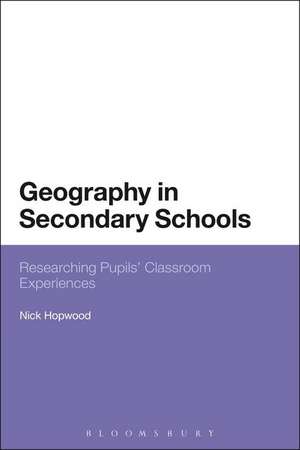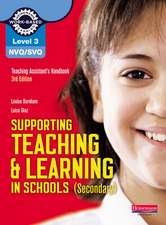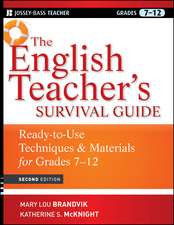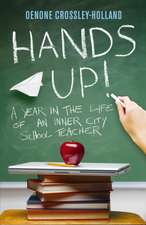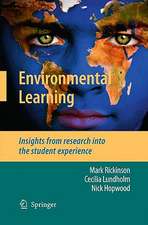Geography in Secondary Schools: Researching Pupils' Classroom Experiences
Autor Dr Nick Hopwooden Limba Engleză Paperback – 9 apr 2014
| Toate formatele și edițiile | Preț | Express |
|---|---|---|
| Paperback (1) | 256.59 lei 6-8 săpt. | |
| Bloomsbury Publishing – 9 apr 2014 | 256.59 lei 6-8 săpt. | |
| Hardback (1) | 831.03 lei 6-8 săpt. | |
| Bloomsbury Publishing – 20 iun 2012 | 831.03 lei 6-8 săpt. |
Preț: 256.59 lei
Preț vechi: 294.91 lei
-13% Nou
Puncte Express: 385
Preț estimativ în valută:
49.10€ • 51.50$ • 40.87£
49.10€ • 51.50$ • 40.87£
Carte tipărită la comandă
Livrare economică 01-15 aprilie
Preluare comenzi: 021 569.72.76
Specificații
ISBN-13: 9781472569172
ISBN-10: 1472569172
Pagini: 224
Ilustrații: illustrations
Dimensiuni: 156 x 234 x 12 mm
Greutate: 0.32 kg
Ediția:NIPPOD.
Editura: Bloomsbury Publishing
Colecția Bloomsbury Academic
Locul publicării:London, United Kingdom
ISBN-10: 1472569172
Pagini: 224
Ilustrații: illustrations
Dimensiuni: 156 x 234 x 12 mm
Greutate: 0.32 kg
Ediția:NIPPOD.
Editura: Bloomsbury Publishing
Colecția Bloomsbury Academic
Locul publicării:London, United Kingdom
Caracteristici
Offers a rich understanding of pupils expectations and experiences of school geography
Notă biografică
Nick Hopwood is Chancellor's Post Doctoral Research Fellow at the University of Technology, Sydney, Australia. He is also a Research Fellow at the Department of Education at the University of Oxford, UK.
Cuprins
AcknowledgementsIntroduction1. School Geography in England2. Building on Prior Research3. Springfield School: Lisa and Bart4. Belmont School: Sara and Matt5. Cedar Grove School: Jenie and Ryan6. Describing and Valuing School Geography7. Thematic Analysis of Pupils' Conceptions8. ConclusionsReferences Index
Recenzii
A brilliant concept. Through the perceptions of Bart, Lisa, Matt, Sara, Jenie, and Ryan, we learn about geography as a school subject. Hopwood takes us into the minds of students - a special place seldom visited by educational researchers.
Nick Hopwood has managed to produce something very different, and in many ways so much more valuable than the conventional research monologue. As he explains in the introduction to Geography in Secondary Schools, this book tells a story about how six pupils experience their geography lessons and develop their ideas about geography as a school subject. The chapters that follow are fascinating, full of the insights gained from a detailed focus on individuals rather than on class groups. Lisa, Bart, Sara, Matt, Ryan and Jenie are real young people (although the names are made up to protect the participants) whose families, social lives, characters and opinions influence and interact with their understanding of geography and of the world around them. Teachers, researchers and geography educators have much to gain from this well written account, but Hopwood's conclusions are also refreshing. He refuses to be drawn into making 'pat' statements about key findings or pedagogical implications, arguing instead that it is enough if we who read this book are moved 'to think beyond ourselves, to pause and take pupils' ideas seriously and as worthy of our attention.' In an age of political meddling with the curriculum, when the teachers' professional role is often undervalued, such encouragement to use our professional skills is both welcome and sound advice.
Nick Hopwood has creatively reversed usual research methodology. He talks with students about their geographic learning. His research builds a compelling case for deep, meaningful discussions with students as a means to both analyse the content of the curriculum, the lessons, and student learning. Readers, and especially teachers, are presented a unique challenge: that being to view the science and art of teaching geography as seen through the eyes of students.
Nick Hopwood has managed to produce something very different, and in many ways so much more valuable than the conventional research monologue. As he explains in the introduction to Geography in Secondary Schools, this book tells a story about how six pupils experience their geography lessons and develop their ideas about geography as a school subject. The chapters that follow are fascinating, full of the insights gained from a detailed focus on individuals rather than on class groups. Lisa, Bart, Sara, Matt, Ryan and Jenie are real young people (although the names are made up to protect the participants) whose families, social lives, characters and opinions influence and interact with their understanding of geography and of the world around them. Teachers, researchers and geography educators have much to gain from this well written account, but Hopwood's conclusions are also refreshing. He refuses to be drawn into making 'pat' statements about key findings or pedagogical implications, arguing instead that it is enough if we who read this book are moved 'to think beyond ourselves, to pause and take pupils' ideas seriously and as worthy of our attention.' In an age of political meddling with the curriculum, when the teachers' professional role is often undervalued, such encouragement to use our professional skills is both welcome and sound advice.
Nick Hopwood has creatively reversed usual research methodology. He talks with students about their geographic learning. His research builds a compelling case for deep, meaningful discussions with students as a means to both analyse the content of the curriculum, the lessons, and student learning. Readers, and especially teachers, are presented a unique challenge: that being to view the science and art of teaching geography as seen through the eyes of students.
